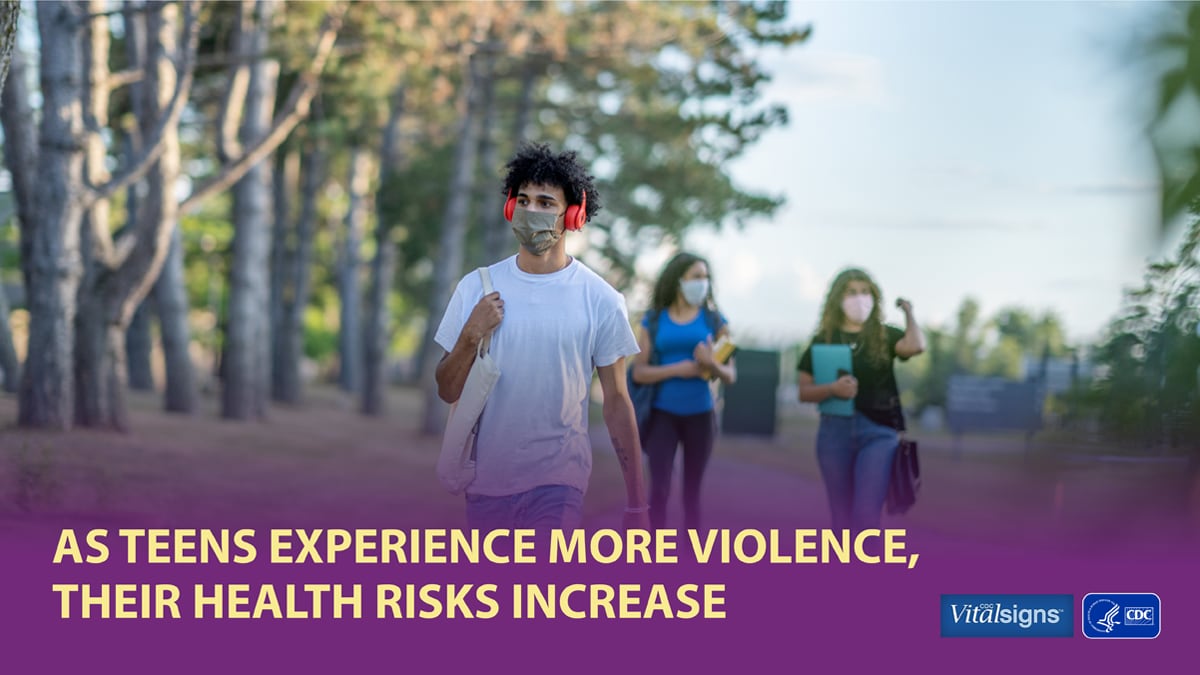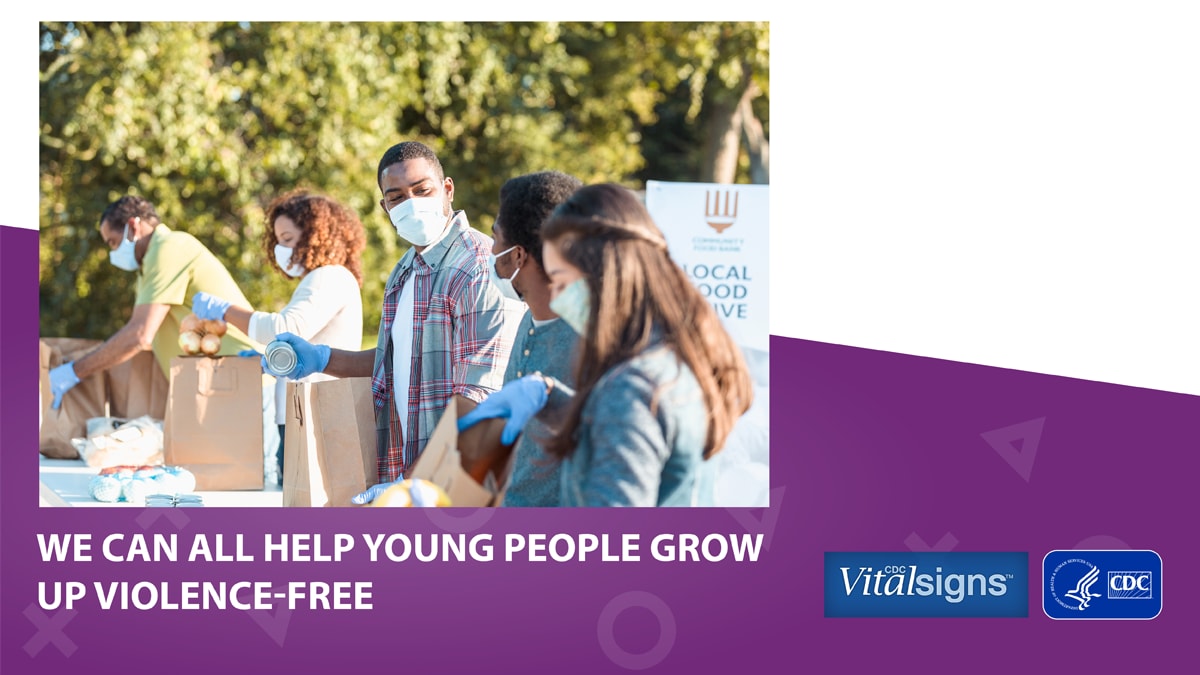Violence Impacts Teens’ Lives
Please note the content on this page is here for historical purposes only and may be out of date as it no longer being updated.
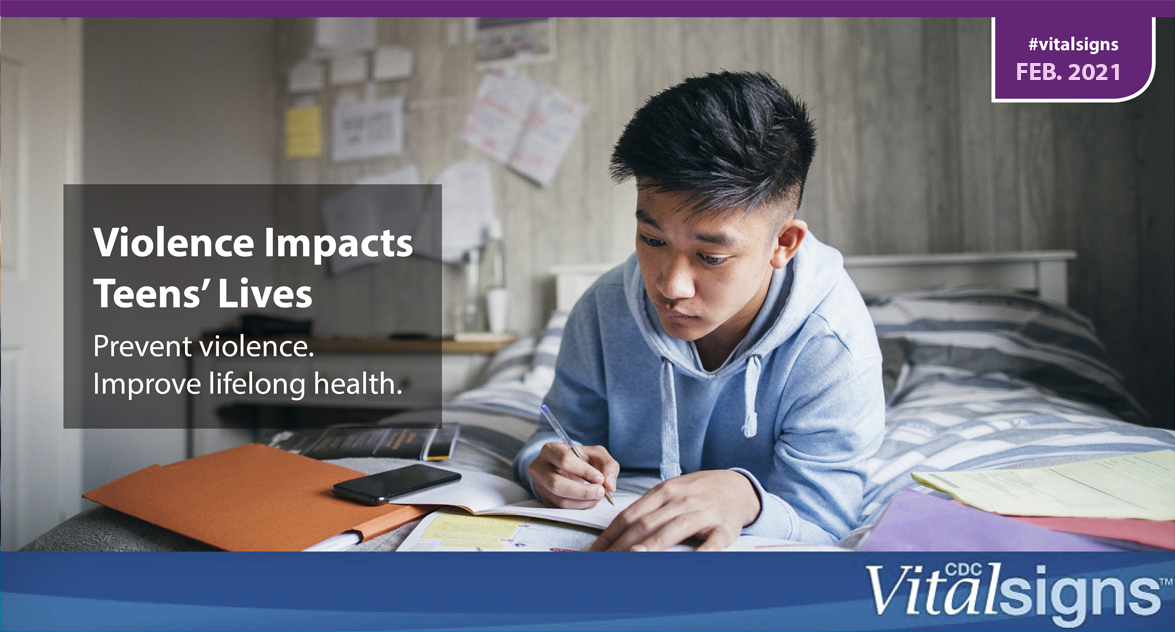
44%
About half (44%) of teens experienced at least one type of violence.*
1 in 7
1 in 7 experienced two or more types of violence.*
16
At least 16 health conditions and risky behaviors are related to experiencing violence.
* during 12 months before the survey
Overview
Violence is preventable. We can all help young people grow up violence-free. Violence can limit life opportunities, lead to emotional and physical health problems, and shorten lives. Far too commonly, teens 14 to 18 years old experience violence, often more than one type such as physical fighting, sexual violence, dating violence, and bullying.
- Every day about 360 teens are treated in emergency departments for assault injuries.
- Homicide is the 3rd leading cause of death among teens.
- Female teens are more likely than males to experience three or more types of violence, as are sexual minority teens compared to their heterosexual peers.
- Some teens may have a higher risk of online bullying and threats during COVID-19.
- Violence can impact school attendance and access to community support services.
Teens who experience violence have several health conditions and risk behaviors, including:
- Missed school due to safety concerns
- Low academic grades
- Carried a weapon
- Suicidal thoughts or behavior
- Risky sexual behavior
- Overweight or obesity
- Felt sad or hopeless
- Substance use
As teens experience more violence, their health risks increase.
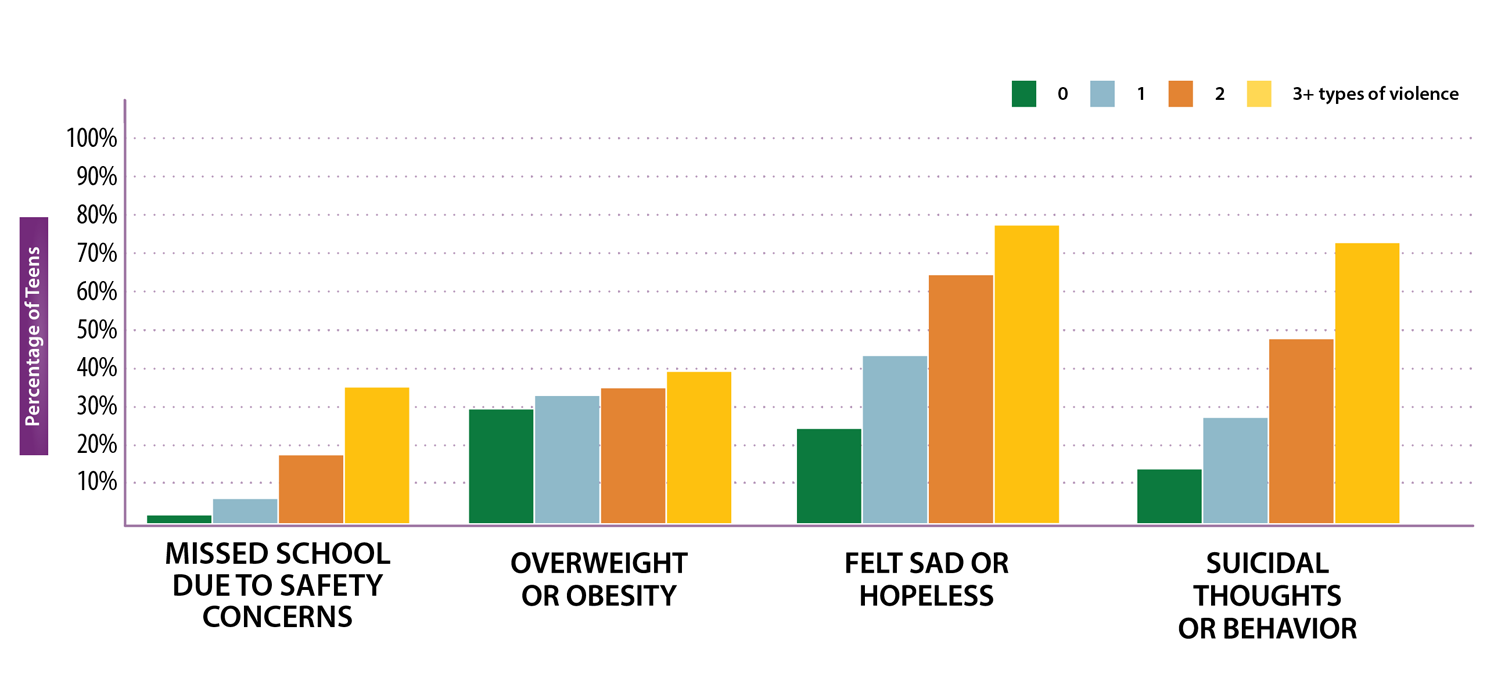
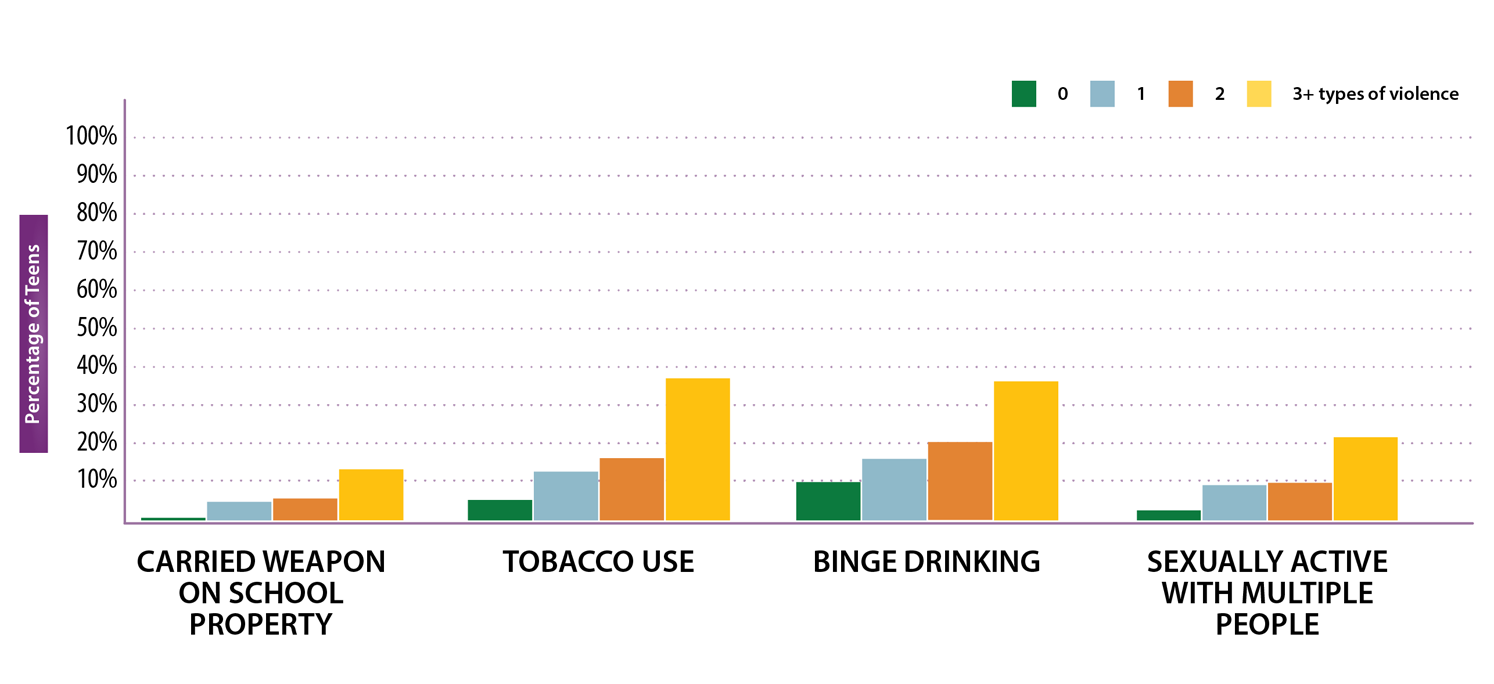
View Text DescriptionView Text Description
SOURCE: Youth Risk Behavior Survey, United States, 2019, CDC Vital Signs, MMWR February 2021.
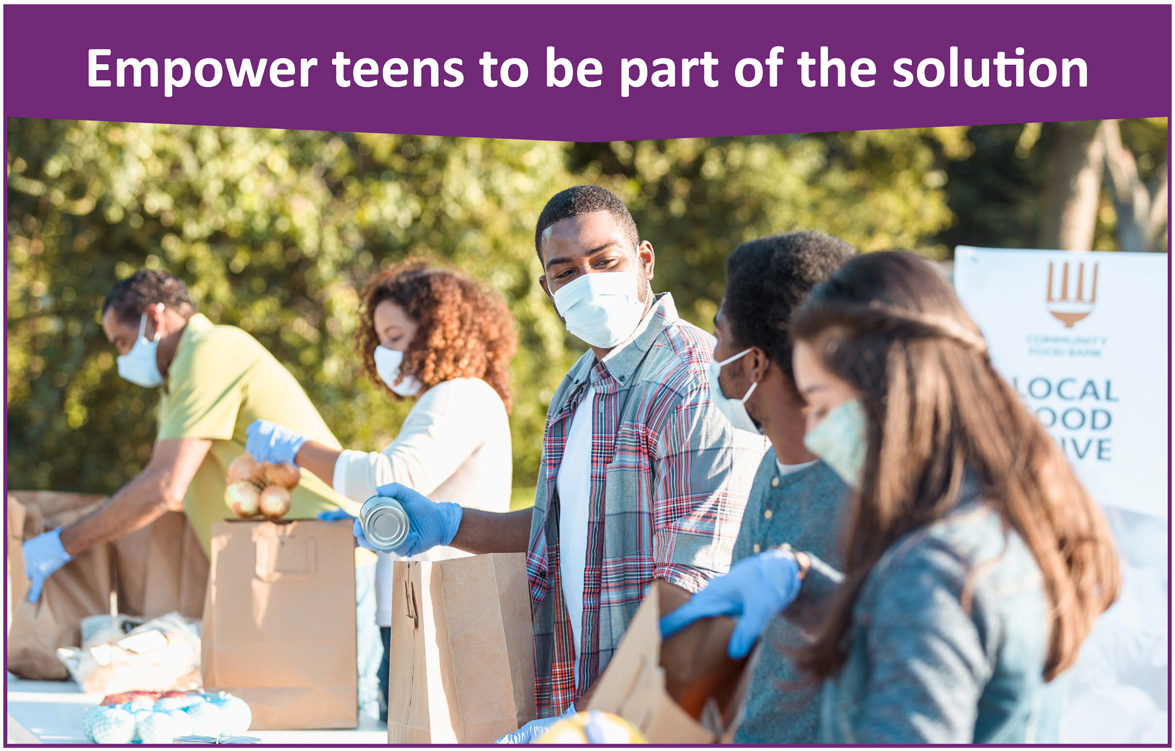
Directly engaging teens in preventing violence helps them:
- Make healthy choices.
- Be a leader and voice for change for healthier communities and schools.
- Advise community and school decision-makers.
- Promote respect and empathy with family, friends, and peers.
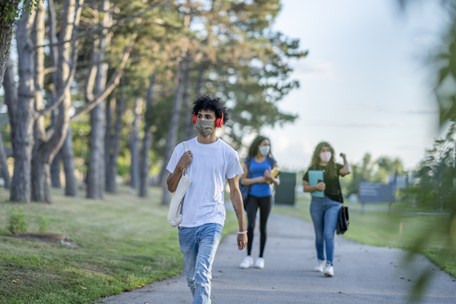
Violence can disrupt teens’ development and harm their current and future health.
Preventing violence is key to promoting teen and adult health.
A teen’s brain is still growing. Experiencing violence during this time of life can harm development and contribute to:
- Impaired decision-making.
- Learning challenges.
- Decreased connections to peers and adults.
- Trouble coping with stress.
Violence can also affect teens’ physical health and increase the chance of developing cancer, heart disease, or other health problems in adulthood.
We can protect teens now and support their growth into healthy adults by preventing violence.
Parents and Families Can:
- Learn about links between teens’ experiences with violence and their health.
- Talk with teens about violence and ask how you can support them.
- Reach out to local programs to learn effective parenting practices.
Communities Can:
- Make teen mentoring, apprenticeship, and leadership programs more available.
- Collaborate with health departments and other partners to promote healthy and safe neighborhoods.
- Make use of effective social and economic policies that reduce violence.
Visit: CDC Technical Packages
Schools Can:
- Adopt policies and practices that create safe and supportive environments.
- Teach teens skills to navigate social and emotional challenges.
- Connect students to health and mental health services.
- Build strong bonds between staff and students to improve connectedness to school.
Visit: CDC What Works in Schools
CDC is taking steps to prevent violence before it starts. Join us!
Sample Facebook Posts
- A teen’s brain is still growing, and violence can disrupt teens’ development + harm their current + future health. Parents, families, communities + schools all play a role in preventing violence for young people. Learn more in new @CDCgov Vital Signs: usa.gov/xAMYj
- New Vital Signs report from @CDCgov shows that teens who identify as gay, lesbian, bisexual or not sure of their sexual identity were more likely to experience violence than their heterosexual peers. Schools can adopt policies and practices to create safe and supportive environments for all young people. Learn more: usa.gov/xAMYj
- Experiencing violence as a teen can harm development and increase the chance of health problems in adulthood. Teens, parents, families, communities, and schools all play a role in preventing violence. Learn more in Vital Signs: usa.gov/xAMYj
- Teens ages 14-18 years old experience violence way too often. We can all help young people live a life free from violence. Learn more in our recent @CDCgov Vital Signs report: usa.gov/xAMYj
Sample Tweets
- A teen’s brain is still growing, and violence can disrupt teens’ development and harm their current and future health. We can all help young people live a life free from violence. Find your role in new @CDCgov #VitalSigns: usa.gov/xAMYj
- New #VitalSigns report shows that teens who identify as gay, lesbian, bisexual or not sure of their sexual identity were more likely to experience violence than their heterosexual peers. Schools can create safe + supportive environments for all young people. Learn more: usa.gov/xAMYj
- At least 16 health conditions and risky behaviors are related to experiencing violence as a teen. As teens experience more violence, their health risks increase. Preventing violence supports young people to become healthy adults. #VitalSigns usa.gov/xAMYj
- Teens ages 14-18 years old experience violence way too often. We can all help young people live a life free from violence. Learn more in the new #VitalSigns: usa.gov/xAMYj
Related Pages and Resources:
- Vital Signs Fact Sheet: Violence Impacts Teens’ Lives [PDF – 613 KB]
- Morbidity and Mortality Weekly Report (MMWR): Vital Signs: Prevalence of Multiple Forms of Violence and Increased Health Risk Behaviors and Conditions Among Youths — United States, 2019
- MMWR: Interpersonal Violence Victimization Among High School Students — Youth Risk Behavior Survey, United States, 2019
- CDC’s Technical Packages for Violence Prevention
- CDC’s Veto Violence
- CDC’s Dating Matters®
- CDC’s Division of Violence Prevention
- CDC’s Violence Prevention: Youth Violence
- CDC’s Adverse Childhood Experiences
- CDC’s Youth Risk Behavior Surveillance System
- CDC’s Division of Adolescent and School Health
- CDC’s Adolescent Health: What Works in Schools
Centers for Disease Control and Prevention
1600 Clifton Road NE
Atlanta, GA 30333
Publication date: February 4, 2021
